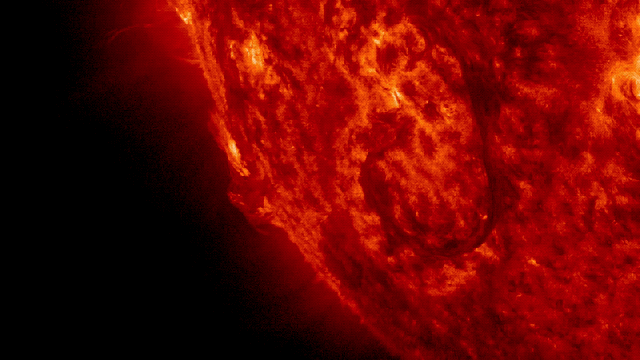Every once in a while our Sun gives off a tremendous belch of high energy particles. Called a coronal mass ejection (CME), these episodes can vary in intensity, but they can produce bursts of electrical charge when they interact with our upper atmosphere in a geomagnetic storm. In a strange twist, new research shows that geomagnetic storms can produce the opposite effect, stripping the upper atmosphere of electrons for hundreds of kilometres. Which, if you like electronic gadgets, may be a problem.
A solar eruption on 26 September 2014. (Image: NASA’s Solar Dynamics Laboratory)
Back on 19 February 2014, a geomagnetic storm appeared in our atmosphere following two powerful Earth-directed CMEs, which produced clouds of electrically-charged particles. As expected, the geomagnetic storm resulted in unstable patches of extra electrons in our planet’s ionosphere (a high-altitude region containing both ions and electrons). But as a new study published in Radio Science shows, the same storm also stripped electrons from large swaths of the ionosphere.
That’s… weird. According to a press release issued by NASA’s Jet Propulsion Laboratory, this observation is new to scientists, who are now in search of an explanation.
It’s important that we get to the bottom of this mystery on account of our ever-increasing vulnerability to space weather, which can cause radio communications to fail, reduce the accuracy of GPS systems, damage satellites, and harm electrical grids. Mild solar storms are a fairly regular occurrence, but once every 50 to 150 years or so our planet is hit with a CME from a massive one. This wasn’t an issue prior to the advent of electronics, but in our highly wired world, these atmospheric disturbances are poised to cause serious trouble.
The 2014 CMEs were tracked by a number of instruments, including a network of global navigation satellites known as GNSS and geomagnetic observatories around the world. Attila Komjathy, a researcher at NASA’s Jet Propulsion Laboratory, developed software to process all this data, which led to the discovery of this unexpected electron-stripping event.
After the Sun released its Earth-bound CMEs, the cloud of charged particles disturbed the interplanetary field in our Solar System. These particles and ensuing magnetic disturbances eventually reached our planet, spawning a geomagnetic storm. The ensuing interactions generated unstable patches of extra electrons in the Arctic ionosphere, in this case over northern Greenland.
But in 2014, the geomagnetic storm did something else. To the south of these patches, the scientists detected broad areas of the ionosphere extending 500 to 1000km where the electrons were severely depleted, and remained way for several days.
A dearth of atmospheric electrons may not sound like a problem, but it might be. Electrons reflect radio waves back to ground level, making long-distance radio communication possible. An overabundance or an absence of electrons within this layer can disrupt the way we use radio signals.
In terms of a cause, the scientists speculate the the electrons are recombining with positively charged ions to the point when excess electrons no longer exist. Alternately, some kind of atmospheric process could be shoving electrons away from the region both horizontally and vertically.
These are just theories, however. Now that this phenomenon has been documented, scientists can start to investigate further.
